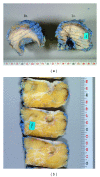Oncoplastic surgery in Japanese patients with breast cancer close to the areola: partial mastectomy using periareolar mammoplasty: a case report
- PMID: 22606571
- PMCID: PMC3350227
- DOI: 10.1155/2011/121985
Oncoplastic surgery in Japanese patients with breast cancer close to the areola: partial mastectomy using periareolar mammoplasty: a case report
Abstract
We report the results of oncoplastic surgery in two Japanese patients with early breast cancer. Their breasts were large and ptotic, and their lesions, which were close to the areola, were considered to be suitable for breast conservative surgery. Oncoplastic surgery involving partial resection of the gland and a periareolar mammoplasty were performed. The technique was easy to perform, and the cosmetic outcome was excellent.
Figures





Similar articles
-
Oncoplastic surgery in a Japanese patient with breast cancer in the lower inner quadrant area: partial mastectomy using horizontal reduction mammoplasty.Breast Cancer. 2014 May;21(3):375-8. doi: 10.1007/s12282-010-0250-5. Epub 2010 Dec 25. Breast Cancer. 2014. PMID: 21188565
-
Oncoplastic breast surgery combining partial mastectomy with V-rotation mammoplasty for breast cancer on the upper inner area of the breast.Surg Today. 2021 Jul;51(7):1241-1245. doi: 10.1007/s00595-020-02152-x. Epub 2020 Oct 8. Surg Today. 2021. PMID: 33033958
-
Oncoplastic surgery for Japanese patients with breast cancer of the lower pole.Surg Today. 2011 Oct;41(10):1461-5. doi: 10.1007/s00595-011-4490-6. Epub 2011 Sep 16. Surg Today. 2011. PMID: 21922380
-
Conservative and radical oncoplastic approches in the surgical treatment of breast cancer.Eur Rev Med Pharmacol Sci. 2008 Nov-Dec;12(6):387-96. Eur Rev Med Pharmacol Sci. 2008. PMID: 19146201 Review.
-
Oncoplastic breast conserving surgery: Volume replacement vs. volume displacement.Eur J Surg Oncol. 2016 Jul;42(7):926-34. doi: 10.1016/j.ejso.2016.02.248. Epub 2016 Mar 4. Eur J Surg Oncol. 2016. PMID: 26988623 Review.
Cited by
-
Oncoplastic breast surgery combining periareolar mammoplasty with volume displacement using a crescent-shaped cutaneous flap for early breast cancer in the upper quadrant.Surg Today. 2013 Aug;43(8):946-53. doi: 10.1007/s00595-013-0506-8. Epub 2013 Feb 27. Surg Today. 2013. PMID: 23443821
References
-
- Audretsch WP, Rezai M, Kolotas C, Zamboglou N, Schnabel T, Bojar H. Tumor-specific immediate reconstruction in breast cancer patients. Perspectives in Plastic Surgery. 1998;11:71–106.
-
- Masetti R, Pirulli PG, Magno S, Franceschini G, Chiesa F, Antinori A. Oncoplastic techniques in the conservative surgical treatment of breast cancer. Breast Cancer. 2000;7(4):276–280. - PubMed
-
- Fitoussi A. Oncoplastic breast surgery. In: Fitoussi A, Berry MG, Couturaud B, Salmon RJ, editors. Oncoplastic and Reconstructive Surgery for Breast Cancer. Berlin, Germany: Springer; 2009. pp. 17–42.
-
- Berry MG, Fitoussi AD, Curnier B, Couturaud B, Salmon RJ. Oncoplastic breast surgery: a review and systematic approach. Journal of Plastic, Reconstructive and Aesthetic Surgery. 2010;63(8):1233–1243. - PubMed
-
- Audretsch WP, Rezai M, Kolotas C, Zamboglou N, Schnabel T, Bojar H. Onco-plastic surgery: “target” volume reduction (BCT-mastopexy), lumpectomy reconstruction (BCT-reconstruction) and flap-supported operability in breast cancer. In: Proceedings of the 2nd European Congress on Senology; October 1994; Vienna, Austria; Moncuzzi, Bologna, Italy. pp. 139–157.
Publication types
LinkOut - more resources
Full Text Sources

